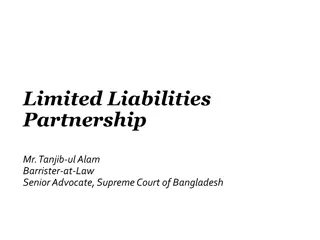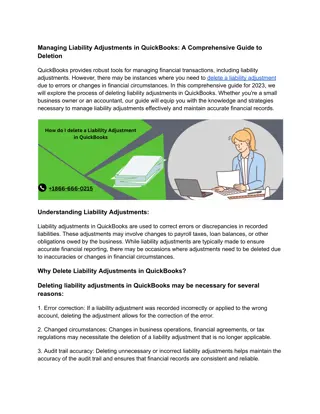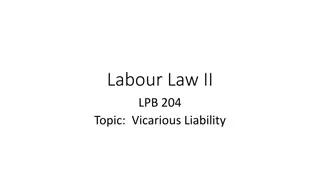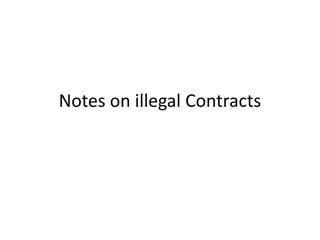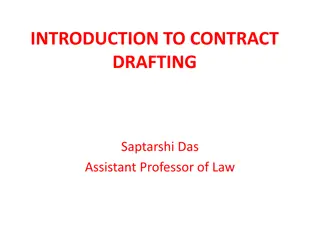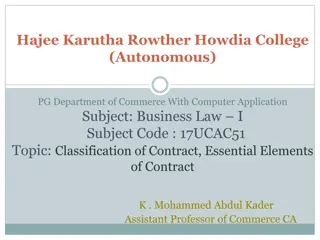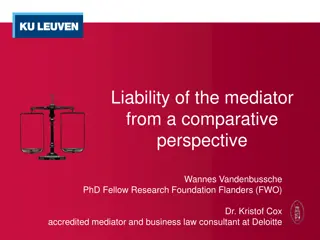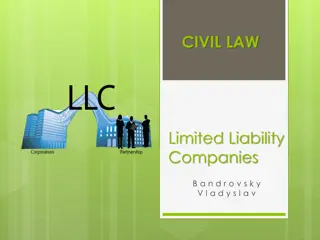Understanding Contractual Liability in Construction Contracts
Contractual liability in construction contracts involves the obligations and responsibilities of parties such as investors and contractors. The liability of investors and contractors is defined by specific regulations in the Civil Code. Investors are responsible for actions like preparing the construction site and accepting the facility, while contractors must ensure the proper performance of the contract. The scope of contractual liability includes the debtor's obligation to remedy damages arising from non-performance or improper performance of obligations, unless due to circumstances for which the debtor is not liable. Additionally, debtors may assume liability for non-performance under specified circumstances, with limitations on clauses exempting debtors from intentional damage.
Download Presentation

Please find below an Image/Link to download the presentation.
The content on the website is provided AS IS for your information and personal use only. It may not be sold, licensed, or shared on other websites without obtaining consent from the author. Download presentation by click this link. If you encounter any issues during the download, it is possible that the publisher has removed the file from their server.
E N D
Presentation Transcript
Contractual liability Contractual liability
Contractual Contractual liability liability The catalogue of entities which are liability includes: Investor Contractor
Contractual Contractual liability liability LIABILITY OF INVERSTOR Art. 647 CC By a construction works contract, the contractor commits to hand over the facility provided for in the contract performed in accordance with the design and technical know-how, and the investor commits to carry out the actions required by the relevant regulations to prepare the works, especially to hand over the construction site and to deliver the design and to accept the facility and pay the agreed remuneration.
Contractual Contractual liability liability LIABILITY OF CONTRACTOR Art. 647 CC By a construction works contract, the contractor commits to hand over the facility provided for in the contract performed in accordance with the design and technical know-how, and the investor commits to carry out the actions required by the relevant regulations to prepare the works, especially to hand over the construction site and to deliver the design and to accept the facility and pay the agreed remuneration.
Contractual Contractual liability liability SCOPE OF CONTRACTUAL LIABILITY Art. 471 CC Debtor's liability for damages. A debtor is obliged to remedy any damage arising from non- performance or improper performance of an obligation unless the non- performance or improper performance is due to circumstances for which the debtor is not liable.
Contractual Contractual liability liability SCOPE OF CONTRACTUAL LIABILITY Art. 473. CC Contract on liability 1. A debtor may, in a contract, assume liability for non-performance or improper performance of an obligation due to specified circumstances for which, under the law, he is not liable. 2. A stipulation that a debtor will not be liable for damage which he may cause to a creditor intentionally is invalid.
Contractual Contractual liability liability Basis of contractual liability in construction contracts: liability on a strict (risk) basis liability on the basis of fault
Contractual Contractual liability liability LIABILITY ON STRICT BASIS Art. 481 CC Delayed monetary performances. 1. If a debtor is late with a monetary performance, the creditor may demand interest for the period of delay even if he has not suffered any damage and even if the delay was due to circumstances for which the debtor is not liable.
Contractual Contractual liability liability LIABILITY ON THE BASIS OF FAULT Art. 472 CC Lack of due care. Unless a special provision of the law or a legal act provides otherwise, a debtor is liable for failure to use due care.
Contractual Contractual liability liability LIABILITY ON THE BASIS OF FAULT Art. 476 CC Debtor's delay; default. A debtor is in default if he does not make the performance on time and, if the time limit is not specified, if he does not make the performance immediately at the creditor's demand. This does not apply where the delay in making the performance is due to circumstances for which the debtor is not liable.
Contractual Contractual liability liability EXCLUSION CONTRACTOR OF LIABILITY Art. 362 CC If an aggrieved party has contributed to damage arising or increasing, the obligation to remedy the damage is appropriately reduced according to the circumstances, and especially to the degree of both parties' fault.
Contractual Contractual liability liability EXCLUSION CONTRACTOR OF LIABILITY Art. 655 CC Risk of destruction of a facility. If a facility is destroyed or damaged as a result of defective materials, machines or equipment supplied by the investor or as a result of work being performed in accordance with the investor's instructions, the contractor may demand the agreed remuneration or an appropriate part thereof if he had warned the investor of the risk of destruction of or damage to the facility beforehand or if, despite having used due care, he could not have determined that the materials, machines or equipment supplied by the investor were defective.
REMEDY OF DAMAGE REMEDY OF DAMAGE
Contractual Contractual liability liability REMEDY OF DAMAGE Art. 363 CC 1. Damage should be remedied, at the aggrieved party's choice, either by the previous condition being restored or a relevant sum of money being paid. If, however, restoration of the previous condition is not possible or it results in excessive difficulties or costs for the obliged person, the aggrieved party's claim is limited to monetary performance. 2. If the damage is to be remedied by payment of money, the amount of the compensation should be set according to prices as at the compensation determination date unless extraordinary circumstances require that prices existing at another time be taken as the basis.
Contractual Contractual liability liability REMEDY OF DAMAGE Art. 477 CC Effects of debtor s default. 1. If the debtor is in default, the creditor may demand, independently of the performance, that any damage caused by the default be remedied. 2. If, however, due to the debtor's default, the performance has become meaningless to the creditor either completely or to a major extent, the creditor may refuse to accept the performance and demand remedy of any damage caused by the non-performance.
Contractual Contractual liability liability REMEDY OF DAMAGE Art. 486. Effects of creditor's default 1. If the creditor is in default, the debtor may demand that any resulting damage be remedied; he may also place the object of the performance in court deposit. 2. A creditor is in default if, without good cause, he either avoids accepting a performance offered or refuses to perform an act without which the performance cannot be made, or represents to the debtor that he will not accept the performance.
Contractual Contractual liability liability REMEDY OF DAMAGE Art. 637. Implied warranty for defects. 1. If a specific work has defects, the orderer may demand that they be removed by giving the person that accepted the order an additional period for this purpose with the stipulation that, after the period passes to no effect, he will not accept the rectification. The person that accepted the order may refuse to rectify the specific work if it entails excessive costs. 2. If the defects cannot be removed or if it follows from the circumstances that the person that accepted the order will not be able to remove them on time, the orderer may rescind the contract if the defects are major; if the defects are minor, the orderer may demand an appropriate reduction in the remuneration. The same applies where the person that accepted the order does not remove the defects during a period set by the orderer. Art. 638. Reference. Unless the preceding articles provide otherwise, the provisions on implied warranty for defects in sales apply accordingly to implied warranty for defects in a specific work.
Contractual Contractual liability liability REMEDY OF DAMAGE 15.4 FIDIC After termination of the Contract under Sub-Clause 15.2 [Termination for Contractor s Default], the Employer shall be entitled subject to Sub-Clause 20.2 [Claims For Payment and/or EOT] to payment by the Contractor of: (a) the additional costs of execution of the Works, and all other costs reasonably incurred by the Employer (including costs incurred in clearing, cleaning and reinstating the Site as described under Sub-Clause 11.11 [Clearance of Site]), after allowing for any sum due to the Contractor under Sub-Clause 15.3 [Valuation after Termination for Contractor s Default]; (b) any losses and damages suffered by the Employer in completing the Works; and
REMEDY OF DAMAGE BY PAYING A SUM OF MONEY REMEDY OF DAMAGE BY PAYING A SUM OF MONEY Liquidated damages Interest for the period of delay
REMEDY OF DAMAGE BY PAYING A SUM OF MONEY REMEDY OF DAMAGE BY PAYING A SUM OF MONEY Art. 483 CC liquidated damages. 1. A contract may stipulate that damage arising from non- performance or improper performance of a non-monetary obligation will be remedied by a specific sum (liquidated damages) being paid. 2. A debtor cannot, without the creditor's consent, be released from the obligation by paying liquidated damages.
REMEDY OF DAMAGE BY PAYING A SUM OF MONEY REMEDY OF DAMAGE BY PAYING A SUM OF MONEY Art. 484 CC Amount. 1. In the event of non-performance or improper performance of an obligation, liquidated damages are due to the creditor in the stipulated amount regardless of the value of the damage suffered. A demand for compensation in excess of the stipulated liquidated damages is not admissible unless the parties have decided otherwise. 2. If the greater part of the obligation has been performed, the debtor may demand that the liquidated damages be reduced; the same applies to the case where the liquidated damages are grossly overstated.
REMEDY OF DAMAGE BY PAYING A SUM OF MONEY REMEDY OF DAMAGE BY PAYING A SUM OF MONEY 8.8 FIDIC Delay Damages If the Contractor fails to comply with Sub-Clause 8.2 [Time for Completion], the Employer shall be entitled subject to Sub-Clause 20.2 [Claims For Payment and/or EOT] to payment of Delay Damages by the Contractor for this default. Delay Damages shall be the amount stated in the Contract Data, which shall be paid for every day which shall elapse between the relevant Time for Completion and the relevant Date of Completion of the Works or Section. The total amount due under this Sub-Clause shall not exceed the maximum amount of Delay Damages (if any) stated in the Contract Data.
REMEDY OF DAMAGE BY PAYING A SUM OF MONEY REMEDY OF DAMAGE BY PAYING A SUM OF MONEY 8.8 FIDIC These Delay Damages shall be the only damages due from the Contractor for the Contractor s failure to comply with Sub-Clause 8.2 [Time for Completion], other than in the event of termination under Sub-Clause 15.2 [Termination for Contractor s Default] before completion of the Works. These Delay Damages shall not relieve the Contractor from the obligation to complete the Works, or from any other duties, obligations or responsibilities which the Contractor may have under or in connection with the Contract. This Sub-Clause shall not limit the Contractor s liability for Delay Damages in any case of fraud, gross negligence, deliberate default or reckless misconduct by the Contractor.
REMEDY OF DAMAGE BY PAYING A SUM OF MONEY REMEDY OF DAMAGE BY PAYING A SUM OF MONEY 15.4 FIDIC After termination of the Contract under Sub-Clause 15.2 [Termination for Contractor s Default], the Employer shall be entitled subject to Sub-Clause 20.2 [Claims For Payment and/or EOT] to payment by the Contractor of: (c) Delay Damages, if the Works or a Section have not been taken over under Sub-Clause 10.1 [Taking Over the Works and Sections] and if the date of termination under Sub-Clause 15.2 [Termination for Contractor s Default] occurs after the date corresponding to the Time for Completion of the Works or Section (as the case may be). Such Delay Damages shall be paid for every day that has elapsed between these two dates.
REMEDY OF DAMAGE BY PAYING A SUM OF MONEY REMEDY OF DAMAGE BY PAYING A SUM OF MONEY Interest for the period of delay Art. 481 CC Delayed monetary performances. 1. If a debtor is late with a monetary performance, the creditor may demand interest for the period of delay even if he has not suffered any damage and even if the delay was due to circumstances for which the debtor is not liable. 2. If the interest rate for delay is not fixed in advance, statutory interest is due. However, if the claim bears interest at a rate higher than the statutory rate, the creditor may demand interest for the delay at the higher rate. 3. If the debtor is in default, the creditor may also demand that the damage be remedied on general terms. Art. 482 CC Interest on overdue interest. 1. Interest for delay may be demanded on overdue interest only from the moment a court action is brought for the interest unless, after the arrears arose, the parties agreed to add the overdue interest to the principal debt.
LIMITATIONS OF CLAIMS OF LIMITATIONS OF CLAIMS OF REMEDY OF DAMAGE REMEDY OF DAMAGE
REMEDY OF DAMAGE BY PAYING A SUM OF MONEY REMEDY OF DAMAGE BY PAYING A SUM OF MONEY LIMITATIONS OF CLAIMS OF REMEDY OF DAMAGE Art. 117 CC 1. Subject to the exceptions provided for in the law, property claims become barred by the statute of limitations. 2. After the limitations period has run, the person against whom a claim is made may avoid satisfying it unless he waives his right to use the statute of limitations as a defense. Waiving the right to use the statute of limitations as a defense before the limitations period has run is, however, invalid.
REMEDY OF DAMAGE BY PAYING A SUM OF MONEY REMEDY OF DAMAGE BY PAYING A SUM OF MONEY LIMITATIONS OF CLAIMS OF REMEDY OF DAMAGE Art. 118 CC Periods Unless a specific regulation provides otherwise, the limitations period is six and for claims concerning periodical performances and claims connected with conducting business activity - two years. Art. 119 CC Limitations periods cannot be shortened or extended by a legal act.
joint and several liability joint and several liability
joint and several liability joint and several liability Types of joint and several liability A. The basic type of joint and several liability B. In solidum liability
joint and several liability joint and several liability The basic type of joint and several liability CONSORTIUM Ar. 58 PPL 1. Economic operators may compete for a contract jointly. 2. In the case referred to in para. 1, economic operators shall appoint a plenipotentiary to represent them in the procurement procedure or to represent in the procedure and to conclude a public contract. 3. The contracting body shall not require from economic operators jointly competing for the award of a contract to have a specific legal form in order to submit a tender or a request to participate. 4. With reference to economic operators jointly competing for a contract, the contracting body may define requirements related to the performance of a contract in a different way than with reference to single economic operators, if this is justified by the nature of the contract and proportional to its subject-matter. 5. The provisions relating to economic operators shall apply accordingly to the economic operators jointly competing for a contract. Art. 445 PPL 1. The economic operators referred to in Article 58 para. 1 shall be jointly and severally liable for the performance of the contract and lodging of a contract performance guarantee.
joint and several liability joint and several liability Joint and several debtors. Art. 366 CC 1. Several debtors may be obliged in such a manner that the creditor may demand the whole or part of a performance from all the debtors jointly, from several of them, or from each of them individually, and satisfaction of the creditor by any of the debtors releases the other debtors (joint and several liability of debtors). 2. All joint and several debtors are liable until the creditor is completely satisfied. Art. 369 CC An obligation is joint and several if it follows from the law or a legal act.
joint and several liability joint and several liability Art. 371 CC Protection of co-debtors. Actions and omissions by one of joint and several debtors cannot operate to the detriment of the co-debtors. Art. 372 CC Running of limitations period. The interruption or suspension of the running of the limitations period with regard to one of joint and several debtors is not effective towards the co-debtors. Art. 373 CC Release of a debtor. The release from debt or waiver of joint and several liability by a creditor with regard to one of joint and several debtors is not effective towards the co-debtors.
joint and several liability joint and several liability Art. 375 CC Defenses. 1. A joint and several debtor may defend himself by raising defenses which he is personally entitled to raise in respect of the creditor, or defenses which are common to all the debtors due to the origin or the substance of the obligation. 2. A judgment passed in favor of one of joint and several debtors releases the co-debtors if it takes into account defenses common to them all.
joint and several liability joint and several liability Art. 376 CC Recourse among co-debtors. 1. If one of joint and several debtors makes the performance, the substance of the legal relationship among the co-debtors decides whether and in what parts such debtor may demand reimbursement from the co-debtors. Unless the substance of the relationship provides otherwise, the debtor who makes the performance may demand reimbursement in equal parts. 2. A part due from an insolvent debtor is divided among the co- debtors.
joint and several liability joint and several liability In solidum liability Art. 6471 CC Contracts with subcontractor 1. The investor is jointly and severally liable with the contractor (general contractor) for the payment of remuneration due to the subcontractor for the construction works performed by him. The detailed subject of this work shell be notificated to the investor by the contractor or subcontractor prior to the commencement of these works, unless within thirty days from the date of delivery of the notification, the investor filed an objection to the subcontractor and the contractor against the performance of these works by the subcontractor. 2. The notification, which is referred to in 1 is not required if the investor and the contractor have specified in the contract, concluded in writing under pain of invalidity, the detailed subject of construction works performed by the designated subcontractor.
joint and several liability joint and several liability In solidum liability Art. 6471 CC Contracts with subcontractor 4. The notification and objection referred to in 1 require a written form under pain of invalidity. 5. The provisions of 1-4 shall apply accordingly to the joint and several liability of the investor, contractor and subcontractor who has signed an agreement with a sub-subcontractor for payment of remuneration to the sub-subcontractor. 6. Contractual provisions contrary to 1-5 are invalid.
joint and several liability joint and several liability In solidum liability Art 447 PPL 1. In the case of works contracts with performance period of more than 12 months, where the contract provides for payment of: 1) the remuneration payable to the economic operator in parts the condition for the payment by the contracting body of the second and subsequent parts of the due remuneration for received works, shall be submission of proofs of payment of the due remuneration to subcontractors and further subcontractors referred to in Article 464 para 1, involved in the performance of the received works; 2) the total remuneration due to the economic operator after the completion of all works the contracting body is obliged to provide for granting of advance payments, while granting further advance payments by the contracting body requires proof of payment of the due remuneration to subcontractors and further subcontractors referred to in Article 464 para. 1, involved in the performance of part of the contract, for which the advance payment was paid. 2. Where the economic operator fails to provide all the proofs of payment referred to in para. 1, suspended respectively is: 1) payment of the remuneration due for the received works, 2) granting another advance payment in part equal to the sum of amounts resulting from unsubmitted proofs of payment. 3. In the case referred to in para. 1 point 1, the contracting body may indicate in the STC the percentage value of the last part of the remuneration, which may not exceed 50% of the remuneration due to the economic operator.


